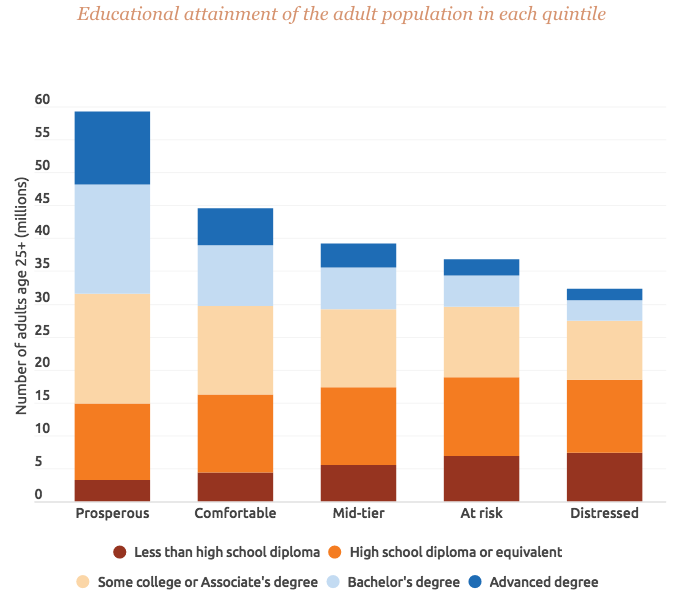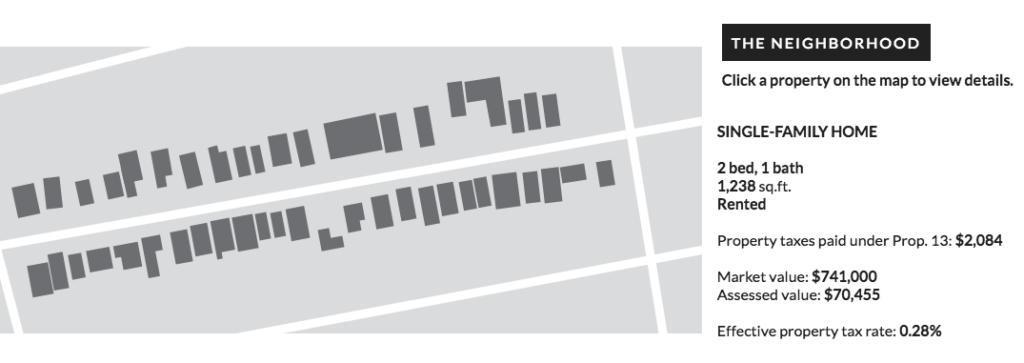What City Observatory did this week
1. Cities talent and prosperity. The latest report from the Economic Innovation Group has some interesting zip code data on the relative economic performance of the nation’s neighborhoods. Their work divides the 25,000 most populated zip codes into five broad groups based on economic health. The leading characsteristic distinguishing the top performers from the distressed zip codes is–no surprise–educational attainment. There are about six times as many highly educated adults in the most prosperous quintile of zip codes as in the most distressed quintile.
While provocative, its useful to remember that zip codes don’t correspond in any meaningful way to functional economies. Much of what this exercise shows is the sorting of the most successful and best educated into some neighborhoods, and the least educated and most troubled into others. So what this is showing us in large part is residential economic segregation, rather than regional economic imbalances.
2. Does ride-hailing cause more car crashes? A new study from the University of Chicago’s Booth Business School finds a correlation between the advent of ride-hailing services and an increase in the number of crashes and fatalities. Despite the statistical association, we’re still skeptical of that ride-hailing caused more crashes. The growth of ride hailing from 2014 through 2016 coincides exactly with a big decline in gas prices and a big increase in vehicle miles and crash rates, a factor not controlled for in the study. Likewise, crash rates increased even more in rural areas (where ride-hailing is rare, if not non-existent) than in cities.
Finally, we could get a much clearer idea of the impact of ride-hailing on crash rates if we looked more closely at the time and location of crashes to see if they coincide with the times and places where ride-hailing is most prevalent.
Must read
1. Strangely, building more homes does reduce a housing shortage. From across the pond comes an insightful column from John Myers, aka London Yimby. Self-inflicted housing shortages seem to be a common element of the Anglo-Saxon heritage. Britain’s housing shortage and high prices, which are the most severe in and around London, trace back to strict limits on development:
If you are lucky enough to own a home in the south-east of the UK, the most expensive element is probably not the cost of building it. It is certainly not the land. It is probably the planning permission for that home to exist.
Land without building permission sells for around 10,000 pounds per acre. Even though the supply of land is fixed, we’ve long since perfected the technology to overcome this natural limitation. Myers explains:
We have a shortage of housing, not land, and housing supply is highly elastic in many places because, as with so many other things since prehistory, we have invented technologies to do more with a limited input: to add more homes on a particular piece of land. You know those technologies as staircases, chimneys, terraced houses, mansion blocks and lifts.
2. Matt Yglesias thinks that California’s rent control initiative, Measure 10, deserves to lose. Yglesias, famously the author of a book entitled “The Rent is Too Damn High,” seems to many like an ironic opponent of rent control. But–like us–he takes the view that rent control measures like those on offer in California cities are more likely to impede the addition of more housing units, which is the only long term answer to the housing shortage in the Golden State (and elsewhere).
. . . what I want people to understand about rent control is that whatever happens with Proposition 10, rent control is not the answer — and certainly not the real answer — to America’s housing woes.
Rent control is, at its best, a regulatory policy that aims to manage scarcity. Many US cities developed housing scarcity during World War II as part of the legacy of the Depression-era collapse in homebuilding paired with wartime restrictions on civilian construction. A giant global war was a perfectly good reason to implement anti-building regulations, and rent control was a perfectly good response to the regulation-induced scarcity.
But modern-day scarcity-inducing regulations are not defeating Hitler. They are, at best, maintaining people’s privileged access to in-demand public schools.
He also forecasts the measure will lose, if only because it jeopardizes the financial interests of single-family homeowners (who are a wide majority of the electorate, and turn out to be more likely to vote than renters). Unfortunately it’s this same NIMBY-tinged voting pattern that makes it hard to reform land use planning in states like California in order to legalize the construction of housing in places where there is the most demand.
New Knowledge
A comprehensive look at the capricious inequity that is Proposition 13. As we’ve said before, California has, in effect, a neo-feudal system of property taxation, in which the amount one pays in property taxes is determined by how old one is, how long someone has been a property-owner, and whether they had the good fortune to be born to parents who owned property in California in 1978 or so. Property is only re-assessed to market value when its sold, and as a result, new purchasers can easily pay five or even ten times as much property tax as their neighbors in identical homes. A new report from CalMatters and several Bay Area public radio stations comprehensively maps the effects of these disparities, showing how much variation there is among Census tracts in the pay area (whole neighborhoods have effective property tax rates half as high as others in the same city). There’s also a microscopic evaluation of tax differentials on a single–quite typical–block in in North Oakland.
Here, within a few hundred feet, effective tax rates vary by a factor of ten.
Decades-long owners of a 1,300 square foot home on one end of the block paid $1,168 in property taxes last year. New homeowners with a smaller home on the other end of the block paid almost 10 times that amount. Two very similar homes, two incredibly different property tax bills.
Prop. 13 has left California with a badly crippled system of public finance. And in two weeks, voters will be asked to add yet another codicil to a growing bundle of neo-feudal rights: Proposition 5 will let homeowners freely transfer their artificially low property valuations to new homes when they move.
In the News
Strongtowns re-published Joe Cortright’s commentary on the limits of job creation, looking at the Equality of Opportunity Project’s latest findings showing the limited impact of local jobs on the lifetime economic prospects of children growing up nearby.




